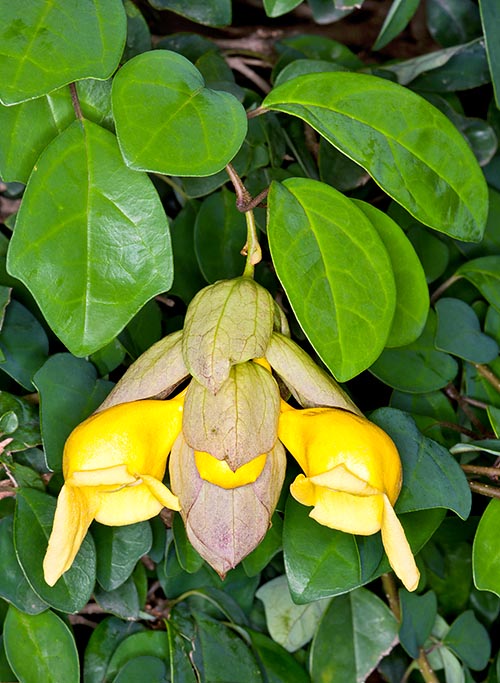Family : Lamiaceae

Text © Pietro Puccio

English translation by Mario Beltramini

Gmelina elliptica reaches 12 m. Odd inflorescences and medicinal virtues © G. Mazza
The species is native to Andaman Islands, Borneo, Cambodia, China (Yunnan), Java, Lesser Sunda Islands, Malaysia, Maluku Islands, Myanmar, Nicobar Islands, Philippines, Sulawesi, Sumatra, Thailand and Vietnam, where it grows along the coasts at the margins of the forests, along the river banks and along the roadsides at low altitudes.
The genus was honoured by Linnaeus to the German physician and botanist Johann Georg Gmelin (1709-1755); the name of the species is the Latin adjective “ellipticus, a, um” = elliptic.
Common names: Badhara bush (English); bohol, talangud (Tagalog); bulangan, belongeh (Malaysian); wareng, bulangan, pongranga (Indonesian), khaang maeo, kra bia luenag, nom maeo (Thai); Tu hú lá bầu dục (Vietnamese).
The Gmelina elliptica Sm. (1810) is a shrub or small evergreen tree 2-4 m tall, even if, occasionally, it may reach 12 m, and diameter of the trunk up to 25 cm, presents straight axillary thorns, 0,5-2 cm long, and opposite elliptic or ovate leaves, at times trilobed, more or less pointed at the apex, 3-8 cm long and 2-5 cm broad, of intense green colour on the upper page, green grey and tomentose below, endowed of small green glands at the base.
Inflorescences in terminal racemes about 10 cm long carrying yellow flowers with bilabiate tubulose corolla, 3-5 cm long and of 2 cm of diameter, with external labrum formed by a unique big lobe and internal labrum trilobed.
The fruits are globose or pyriform drupes, about 2 cm long and of 1,5 cm of diameter, yellow when ripe, usually containing 2 seeds. It easily reproduces by seed, with the first flowering at the second, third year of age; the seeds are dispersed by the birds who contribute in its diffusion, so much that it has been naturalized in various tropical and subtropical zones, becoming a pest and suffocating the pre-existent vegetation.
It is a vigorous and fast growing species, suitable to tropical and subtropical climates in full sun; not particular about the soil, even poor, and bears drought periods. Occasionally utilized as ornamental plant, but not recommended, and in some instances forbidden, in the zones where it can naturalize, and as subject for bonsai. Leaves and fruits are utilized in the traditional medicine for various pathologies.
Synonyms: Gmelina asiatica var. villosa (Roxb.) Bakh. (1821); Gmelina villosa Roxb. (1832).
→ To appreciate the biodiversity within the family LAMIACEAE please click here.
